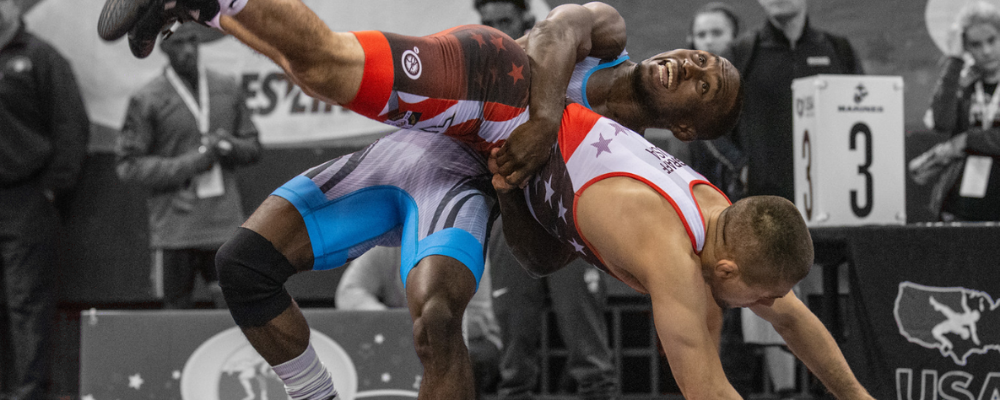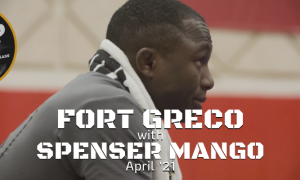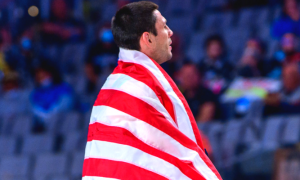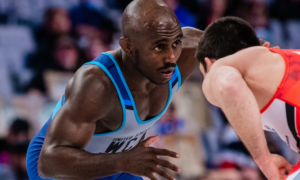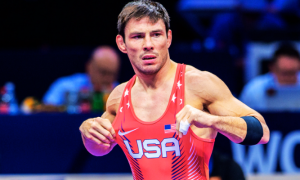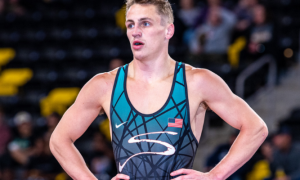When most wrestling fans think of Ryan Mango (60 kg, Army/WCAP), visions of high-explosive throws dance through their heads. And, make no mistake: that’s what they should be thinking. Mango, like a coiled spring, has introduced many dozens of opponents to the sensation of anti-gravity, and often in spectacular fashion. In fact, his delightful talent in this regard has been on display in the most crucial of events. Just count ’em up: a few National Team appearances, a pair of US Open titles, a Pan-Am Championships gold, and a spot on the 2019 World Team are suitable proof of Mango’s metronome-like consistency.
But maybe subbing out the word “throws” and replacing it with “lifts” is a little more accurate — especially when it comes to Mango’s last three performances at the Nationals.
Mango won his first US Open crown in ’18, added his second the next year, and this past December was running along smoothly until he bowed out due to a minor knee injury. He was 3-0 prior to defaulting, winning all three bouts via technical superiority. Which in a nutshell is Mango’s very own recent US Open paradigm. In his last three showings, Mango’s VFR (Victory Finish Rate) rings in at 80% (through ten matches).
The majority of points Mango earned in this trio of National tournaments came from par terre, not throws on the feet. It bears mentioning that he is, indeed, a thrower when standing. You will not find it very difficult to locate a slew of Mango’s matches and catch glimpses of him launching opponents, and rather effortlessly. But domestically, especially over the course of his latest stretch — which may potentially be the most important of his career — he has done the lion’s share of his great good work from PT. That is important to note with an Olympic Trials on the horizon, if only because we should all recognize by now that important team-selection events often demand clutch action on the mat.
As a refresher, you may want to visit these links for stat explanations:
General
Counter Scores
Par Terre
Ryan Mango: Recent US National Results
2018 US Open
WON Andrew Ibrarra 8-0, TF
WON Colton Rasche 9-0, TF
WON Jesse Thielke 9-0, TF
WON Sammy Jones 6-1
(“Attempt” and “Counter Score” stats do not include Ibarra)
W/L: 4-0
PL: 1st
OPA: 8.0
OPP: 6.4
PPM: 7.25
PPP: 5.8
VFR: 75%
CSPM: 8.25
AMV: 7.25
APM: 0.5
APP: 0.4
ACR: 2.0
MPSM: 3.0
TCSP: 4.0
CSA: 0.8
PTSM: 5.0
PTEP: 100%
PTB: 1
PTDR: 100%
PTPS: 0.0
Mango’s opening bout versus Ibarra was not available for review, which means that we cannot account for Attempts or Counter Scores. But we do know that four of Mango’s points against Ibarra were scored from par terre. He then went on to add eight more PT points after downing Rasche and Thielke. In total, 20 of the 30 points for which Mango was credited at the US Open arrived from par terre top. Two of his PT executions were of the four-point variety (lifts), so it wasn’t as though he relied solely on running gutwrenches. After all, bombastic lifts are one of Mango’s primary calling cards.
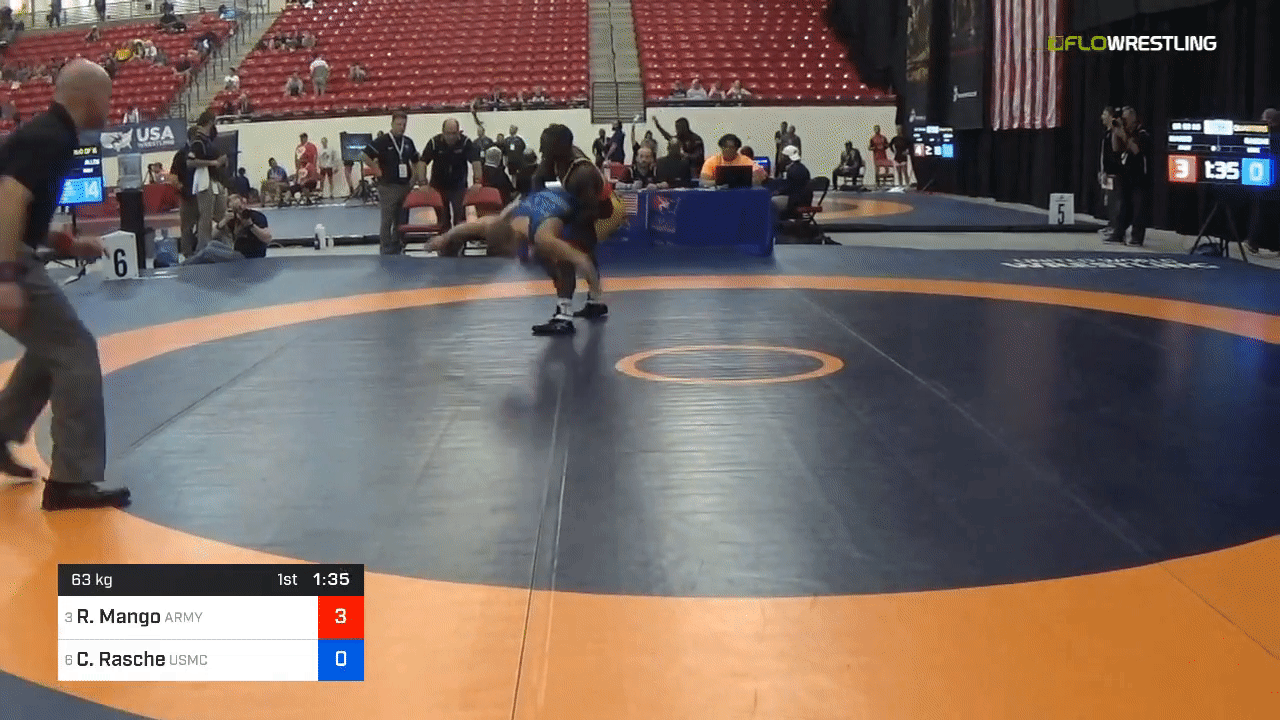
This lift-and-gut sequence from Mango delivered six of the eight offensive points he scored en-route to victory over Colton Rasche (Marines) in the quarterfinal round of the ’18 US Open. (Image: FLOWrestling)
No matter how you slice it, a PTSM of 5.0 for any athlete at a National event (who only walked out for the second period once in four matches) is indicative of an extreme and devastating level of ability from that one position.
Sammy Jones (NYAC/NTS) was the only opponent of Mango’s to avoid being turned. That was in the final, where Mango accrued his only counter score of the tournament. In the first period, Jones received the passivity and wound up ratcheting a front headlock. Mango submarined up and bodylocked Jones for four.
Mango’s Attempts stat line in ’18 was on the low side. His ACR of 2.0 was excellent, however (remember: 2.0 suggests an athlete scored on every other attempt). But there weren’t many attempts of which to speak. Anecdotally, Mango achieved a pair of takedowns in his match with Ibarra. If it could be confirmed that he went two-for-two (attempts to conversions) in that bout, it would beef his total attempts number to four and his ’18 US Open ACR would have been an insane 1.3.
2019 US Open
WON Jarod Maes 10-0, TF
WON Travis Rice 3-3
WON Sammy Jones 9-1, TF
W/L: 3-0
PL: 1st
OPA: 7.3
OPP: 4.4
PPM: 6.6
PPP: 4.0
VFR: 66%
CSPM: 8.6
AMV: 6.0
APM: 2.6
APP: 1.6
ACR: 5.0
MPSM: 1.6
TCSP: N/A
CSA: N/A
PTSM: 2.6
PTEP: 50%
PTB: 2.0
PTDR: 50%
PTPS: 0.6
Rice provided Mango with an extremely stiff test in the semifinal, and this is the only match out of the ten represented in this article excluding an offensive score. Mango received a passivity point and another two from a caution. That’s it. As such, this one bout — aside from serving as the clear outlier in what is a limited sample size — is responsible for bringing Mango’s major efficiency values down a couple of notches. He was credited for seven attempts against Rice — but converted zero. He was also turned by Rice (for two), hence his PTDR of 50%, and he was unable to net a positive yield from par terre top, diminishing his PTEP at the tournament to 50%, as well.
Now, a little context is helpful for storytelling purposes. Mango had returned to competition the week prior at the Pan-Am Championships after requiring six-plus months to recover from arm surgery. In addition, his ankle got cranked in the bout with Rice, and that may have stymied his offensive production and efficiency. You say “may” because it is an inference. It is also immaterial. We are only concerned with the numbers, and in this particular case, they were all uncharacteristically down against Rice. Then again, Rice is an outstanding wrestler who is capable of adapting game plans specifically designed to nullify his opponents’ strengths.
So then you look at his other two bouts. In the opener, Mango was two-for-two Attempts/Conversions against Maes; and against Jones in the final, six of Mango’s eight offensive points were the result of his par terre work. This is why outlier bouts are critical, because they invite questions fans and coaches would want answered (e.g., What happened in that match?)
Of course, even with the Rice bout, Mango’s stats are, for the most part, sparkling. He averaged just over six offensive points per match and four points per period; and won each match by an average of six points (AMV). Plus, his PTEP and PTDR wound up negligible, which in the United States at least, tends to suggest above-average PT competence.
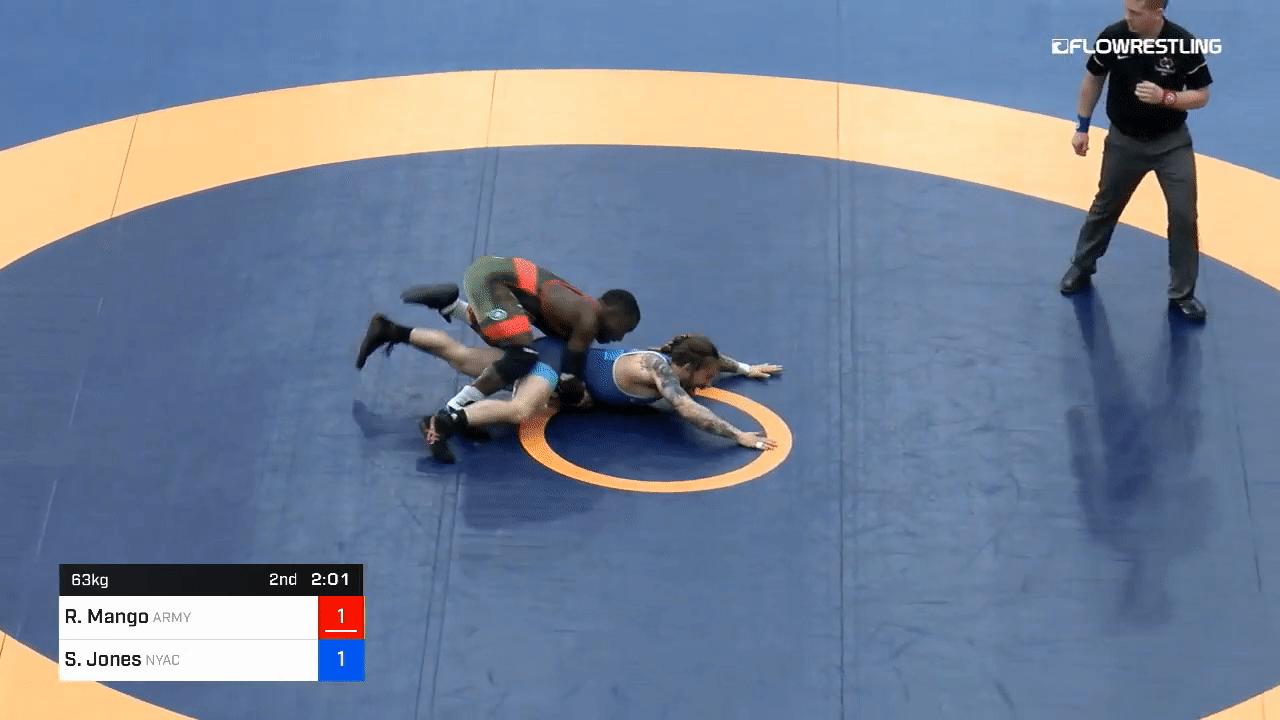
Jones (blue) held a 1-0 lead against Mango entering the second period of their 63-kg US Open final in ’19. Then Mango received the passivity/PT chance and immediately went to work, eventually tacking on eight straight points with the first two the result of this snappy gutwrench. (Image: FLOWrestling)
2019 US Nationals/Olympic Trials Qualifier
WON Jon Massey 12-4, TF
WON Tyler Graff 8-0, TF
WON David Stepanian 8-0, TF
W/L: 3-0
PL: 6th/DNF
OPA: 9.3
OPP: 9.3
PPM: 9.0
PPP: 9.0
VFR: 100%
CSPM: 10.6
AMV: 9.0
APM: 0.6
APP: 0.6
ACR: 1.0
MPSM: 3.0
TCSP: 2.0
CSA: 0.6
PTSM: 6.0
PTEP: 100%
PTDR: N/A
PTPS: N/A
PTSM: 6.0
PTEP: 100%
PTDR: N/A
PTPS: N/A
December’s ’19 US Nationals — a tournament Mango did not even need to enter since he had qualified for the Olympic Trials the moment he won Final X — offers the best expression of his par terre dominance. He scored six PT points in each of his three matches, accounting for 64% of his overall points yield (28). Mango also won via tech in all three bouts (in the first period); and naturally, because PT points are multi-point scores, his MPSM for the tournament rang in at a robust 3.0.
Again, the Attempts stats are on the low side. But — Mango never reached the second period. Two attempts were logged, one against Massey and another versus Stepanian, meaning he was two for two — and, there are two different ways to read into that: 1) Mango doesn’t love making a lot of attempts, or feels he doesn’t need to; 2) when he does make attempts, it is usually worth his while.

It’s not always a flowery, arching side lift or bodylock. Sometimes, Mango will finish his lifts in a more linear fashion if the opponent tries to turn inside as a measure of defense. When that happens, Mango will hoist and high-leg to ensure his points yield. (Image: FLOWrestling)
Mash ‘Em Together
W/L: 10-0
OPA: 8.2
OPP: 6.3
PPM: 7.5
PPP: 5.7
VFR: 80%
CSPM: 9.1
AMV: 7.4
APM: 1.4
APP: 1.07
ACR: 2.8
MPSM: 2.7
TCSP: 6
CSA: 0.6
PTSM: 4.6
PTEP: 77%
PTB: 3
PTDR: 66%
PTPS: 0.2
Mango earned a total of 75 offensive points across his ten matches contested at the past three Senior National events. 46 of those points (61%) were the result of his penchant for gutting and lifting opponents from par terre. Six of his PT executions were scored for four points.
You always want to see a disparity between PTEP and PTDR. Mango’s ratio of 77% to 66% — even though he was only on par terre bottom thrice — is more than solid. His PTSM of 4.6 is yet one more figure illustrating how lopsided his matches can become so long as he gets his shot.
Par terre is not the only way Mango is able to triumph. He won three bouts either without turning his opponent, or without having had the chance to do so. Moreover, par terre being responsible for the majority of earned points is not exactly newsworthy, considering it is how most high-level Greco athletes make their money (metaphorically speaking).
But in the lighter weight categories, particularly in the US, it is hard not to take notice when there is a wrestler who is both piling up a lot of PT points and ending matches at such a high rate. That this has all been occurring at the biggest domestic event on the calendar only serves to further contribute to Mango’s undeniable strength from a position on which he did not even focus for a substantially large portion of his entire wrestling life. Despite his outstanding age-group career, Mango did spend his college years wrestling folkstyle. Sure, he hopped over to Greco each spring and competed extraordinarily well, but he was also called back to the dark side once autumn arrived.
Now 28 and a true full-timer for the past seven years, Mango’s style has naturally evolved. He is a problem to deal with on the feet, primarily because most cannot keep up with his explosiveness. They know that at any second, something dramatic might occur. At the same time, he is unerringly patient. Mango does not force attempts too often. Rather, he likes to simply keep his opponents’ feet moving, which fabricates angles he can exploit for the attempts he does make.
And that’s the key. Everyone knows Mango has the sauce to drum up takedowns or flash into high-dive bodylocks. But he doesn’t have to extend himself to score. If the action is bogged down on the feet, all Mango has to do is stay alive long enough to get to par terre. When he does that, he is exceedingly difficult to beat.
Listen to “5PM37: The wildman Sammy Jones” on Spreaker.
SUBSCRIBE TO THE FIVE POINT MOVE PODCAST
iTunes | Stitcher | Spreaker | Google Play Music


